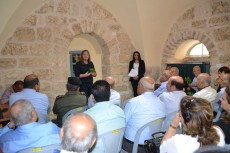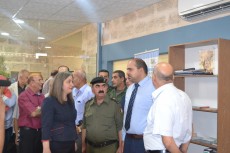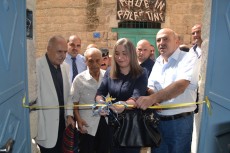Implemented through the "Local Development through the Rehabilitation and Revitalization of the Historic Built Environment in Palestine" programme and funded by the Government of Sweden - Swedish International Development Cooperation Agency "Sida" through the United Nations Educational, Scientific and Cultural Organization "UNESCO" - Ramallah Office. The building is currently used by the Palestinian Center for Rapprochement between People.
 Mrs. Rula Ma’aia, Mr. Hani Al-Hayek mayor of Beit Sahour, Major Adnan Naif PR officer at the National Security on behalf the commander of Bethlehem area, representative of UNESCO – Ramallah Office Mr. Mohammad Abu Hammad and number of organizations representative and local community attended the event.
Mrs. Rula Ma’aia, Mr. Hani Al-Hayek mayor of Beit Sahour, Major Adnan Naif PR officer at the National Security on behalf the commander of Bethlehem area, representative of UNESCO – Ramallah Office Mr. Mohammad Abu Hammad and number of organizations representative and local community attended the event.
Mr. Al-Hayek praised the role of each of the Swedish government, UNESCO, the owners of the building and the CCHP for its efforts in reviving the heritage and preserving our cultural identity and contributing to job creation, especially in the ancient town of Beit Sahour.
Arch. Issam Juha, director of CCHP welcomed the honorable guests and pointed out that the rehabilitated projects reduce unemployment by providing jobs and maintaining Palestinian heritage. This project is a complement to the rehabilitation interventions to revive the ancient town of Beit Sahour and give it a touch of aesthetic and develop tourism. Arch. Juha thanked MOTA, Beit Sahour Municipality, Governorate, and Swedish government, UNESCO, owners of the building, project contractor, Steering Committee and CCHP staff for their continuous efforts in preserving the cultural heritage.
In turn, Mr. George Rishmawi Director of PCR stressed on the impact of these projects in supporting the active institutions and their role in the revival of the Old City through the vital programmes that encourage the influx of people to the area, and thanked all those who contributed to the success of the project and provide a headquarters for PCR, Siraj Center and Abraham Path.
UNESCO office pointed to the importance of these projects in contributing to preserving cultural heritage. It also reflects the civilization and culture of the Palestinian people.
 In turn, Mrs. Ma’aia expressed her delight to inaugurate these projects, and thanked the Swedish government for its continuous support for infrastructure projects and traditional buildings to be used for productive, social, cultural and health purposes. She also praised the efforts of CCHP since 2001 in this area, and in providing opportunities for temporary and permanent jobs and adapting buildings for community service.
In turn, Mrs. Ma’aia expressed her delight to inaugurate these projects, and thanked the Swedish government for its continuous support for infrastructure projects and traditional buildings to be used for productive, social, cultural and health purposes. She also praised the efforts of CCHP since 2001 in this area, and in providing opportunities for temporary and permanent jobs and adapting buildings for community service.
After the ceremony, the delegation had a tour around the building, where CCHP presented photos showing the building before and after rehabilitation.










